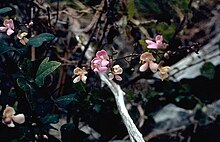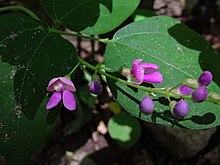|
Phaseolus polystachios
 Phaseolus polystachios, also known as the thicket bean or wild kidney bean, is a perennial, herbaceous vine that is native to North America.[2][1] It is unique among the Phaseolus in that its native range extends across the eastern temperate United States to southeast Canada, while most Phaseolus are tropical or subtropical.[2] It is the namesake for the Polystachios group clade, which is the most species-rich within Phaseolus (17 species).[3] In spite of its common name, it is more closely related to the lima bean (Phaseolus lunatus), and it holds potential as a crop wild relative due to its resistance to white mold (Sclerotinia sclerotiorum).[4] Subordinate taxaSubordinate taxa include Phaseolus polystachios var. polystachios, Phaseolus polystachios var. sinuatus, and Phaseolus polystachios var. smilacifolius.[2][5] The Phaseolus polystachios var. polystachios variety is listed as a special concern species and believed extirpated in Connecticut.[6] Ethnobotany and usesPhaseolus polystachios has been found in a few Native American archaeological sites in Oklahoma and Arkansas, with some evidence of artificial selection for indehiscent (non-shattering) pods.[7] Its fruit and seeds can reportedly be eaten in much the same way as cultivated Phaseolus, although they are smaller.[7] Life historyPhaseolus polystachios exhibits hypogeal germination and is photoperiod sensitive, requiring day lengths greater than 10 hours to vine and flower.[8][9] It overwinters via a tuberous root system.[8][9] EcologyPhaseolus polystachios inhabits well-drained soils and slopes, generally woodlands and thickets, and may form colonies.[9] Their pods are eaten extensively by weevils.[4][9] References
|
||||||||||||||||||||||||||||||||||||||

